Normal and Friedreich ataxia cells express different isoforms of frataxin with complementary roles in iron-sulfur cluster assembly
- PMID: 20889968
- PMCID: PMC2992281
- DOI: 10.1074/jbc.M110.145144
Normal and Friedreich ataxia cells express different isoforms of frataxin with complementary roles in iron-sulfur cluster assembly
Erratum in
- J Biol Chem. 2011 Mar 11;286(10):8708
Abstract
Friedreich ataxia (FRDA) is an autosomal recessive degenerative disease caused by insufficient expression of frataxin (FXN), a mitochondrial iron-binding protein required for Fe-S cluster assembly. The development of treatments to increase FXN levels in FRDA requires elucidation of the steps involved in the biogenesis of functional FXN. The FXN mRNA is translated to a precursor polypeptide that is transported to the mitochondrial matrix and processed to at least two forms, FXN(42-210) and FXN(81-210). Previous reports suggested that FXN(42-210) is a transient processing intermediate, whereas FXN(81-210) represents the mature protein. However, we find that both FXN(42-210) and FXN(81-210) are present in control cell lines and tissues at steady-state, and that FXN(42-210) is consistently more depleted than FXN(81-210) in samples from FRDA patients. Moreover, FXN(42-210) and FXN(81-210) have strikingly different biochemical properties. A shorter N terminus correlates with monomeric configuration, labile iron binding, and dynamic contacts with components of the Fe-S cluster biosynthetic machinery, i.e. the sulfur donor complex NFS1·ISD11 and the scaffold ISCU. Conversely, a longer N terminus correlates with the ability to oligomerize, store iron, and form stable contacts with NFS1·ISD11 and ISCU. Monomeric FXN(81-210) donates Fe(2+) for Fe-S cluster assembly on ISCU, whereas oligomeric FXN(42-210) donates either Fe(2+) or Fe(3+). These functionally distinct FXN isoforms seem capable to ensure incremental rates of Fe-S cluster synthesis from different mitochondrial iron pools. We suggest that the levels of both isoforms are relevant to FRDA pathophysiology and that the FXN(81-210)/FXN(42-210) molar ratio should provide a useful parameter to optimize FXN augmentation and replacement therapies.
Figures
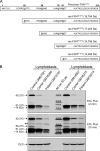
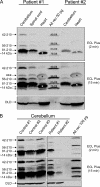
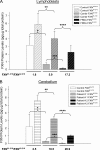
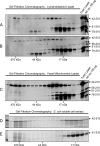


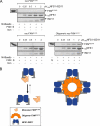
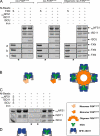


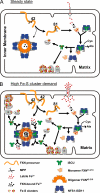
Similar articles
-
Structure-function analysis of Friedreich's ataxia mutants reveals determinants of frataxin binding and activation of the Fe-S assembly complex.Biochemistry. 2011 Aug 23;50(33):7265-74. doi: 10.1021/bi200895k. Epub 2011 Aug 2. Biochemistry. 2011. PMID: 21776984 Free PMC article.
-
Architecture of the Human Mitochondrial Iron-Sulfur Cluster Assembly Machinery.J Biol Chem. 2016 Sep 30;291(40):21296-21321. doi: 10.1074/jbc.M116.738542. Epub 2016 Aug 12. J Biol Chem. 2016. PMID: 27519411 Free PMC article.
-
Missense mutations linked to friedreich ataxia have different but synergistic effects on mitochondrial frataxin isoforms.J Biol Chem. 2013 Feb 8;288(6):4116-27. doi: 10.1074/jbc.M112.435263. Epub 2012 Dec 26. J Biol Chem. 2013. PMID: 23269675 Free PMC article.
-
Frataxin and mitochondrial FeS cluster biogenesis.J Biol Chem. 2010 Aug 27;285(35):26737-26743. doi: 10.1074/jbc.R110.118679. Epub 2010 Jun 3. J Biol Chem. 2010. PMID: 20522547 Free PMC article. Review.
-
Mechanisms of Mitochondrial Iron-Sulfur Protein Biogenesis.Annu Rev Biochem. 2020 Jun 20;89:471-499. doi: 10.1146/annurev-biochem-013118-111540. Epub 2020 Jan 14. Annu Rev Biochem. 2020. PMID: 31935115 Review.
Cited by
-
PMPCA mutations cause abnormal mitochondrial protein processing in patients with non-progressive cerebellar ataxia.Brain. 2015 Jun;138(Pt 6):1505-17. doi: 10.1093/brain/awv057. Epub 2015 Mar 25. Brain. 2015. PMID: 25808372 Free PMC article.
-
Zinc and the iron donor frataxin regulate oligomerization of the scaffold protein to form new Fe-S cluster assembly centers.Metallomics. 2017 Jun 21;9(6):773-801. doi: 10.1039/c7mt00089h. Metallomics. 2017. PMID: 28548666 Free PMC article.
-
Iron-sulfur cluster deficiency can be sensed by IRP2 and regulates iron homeostasis and sensitivity to ferroptosis independent of IRP1 and FBXL5.Sci Adv. 2021 May 26;7(22):eabg4302. doi: 10.1126/sciadv.abg4302. Print 2021 May. Sci Adv. 2021. PMID: 34039609 Free PMC article.
-
Iron-sulfur cluster synthesis, iron homeostasis and oxidative stress in Friedreich ataxia.Mol Cell Neurosci. 2013 Jul;55:50-61. doi: 10.1016/j.mcn.2012.08.003. Epub 2012 Aug 11. Mol Cell Neurosci. 2013. PMID: 22917739 Free PMC article. Review.
-
Recent Advances in the Elucidation of Frataxin Biochemical Function Open Novel Perspectives for the Treatment of Friedreich's Ataxia.Front Neurosci. 2022 Mar 2;16:838335. doi: 10.3389/fnins.2022.838335. eCollection 2022. Front Neurosci. 2022. PMID: 35310092 Free PMC article. Review.
References
-
- Harding A. E. (1981) Brain 104, 589–620 - PubMed
-
- Campuzano V., Montermini L., Moltò M. D., Pianese L., Cossée M., Cavalcanti F., Monros E., Rodius F., Duclos F., Monticelli A., Zara F., Cañizares J., Koutnikova H., Bidichandani S. I., Gellera C., Brice A., Trouillas P., De Michele G., Filla A., De Frutos R., Palau F., Patel P. I., Di Donato S., Mandel J. L., Cocozza S., Koenig M., Pandolfo M. (1996) Science 271, 1423–1427 - PubMed
-
- Wells R. D. (2008) FASEB J. 22, 1625–1634 - PubMed
-
- Karthikeyan G., Santos J. H., Graziewicz M. A., Copeland W. C., Isaya G., van Houten B., Resnick M. A. (2003) Hum. Mol. Genet. 12, 3331–3342 - PubMed
Publication types
MeSH terms
Substances
Grants and funding
LinkOut - more resources
Full Text Sources
Other Literature Sources
Medical
Miscellaneous

